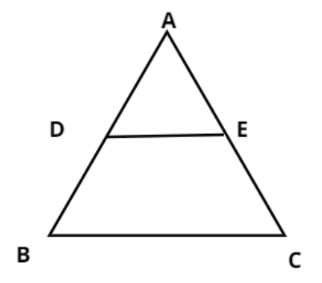
In the figure D and E are points on the sides AB and AC respectively of a $\vartriangle ABC$ such that ${\text{DE||BC}}$ and divides $\vartriangle ABC$ into two parts, equal in area, find $\dfrac{{BD}}{{AB}}$.


Answer
606.6k+ views
Hint: In this problem we have been with a triangle ABC such that the line segment DE inside this triangle is parallel to BC. So BCED forms a trapezium now and it is given that this DE divides this triangle into two equal areas. Thus use the respective formula for area of triangle and area of trapezium along with triangle congruence postulates to reach the answer.
Complete step-by-step answer:
It is given that the area of triangle ADE is equal to the area of trapezium BCED.
$ \Rightarrow {\text{Area}}\left( {\Delta ADE} \right) = {\text{Area}}\left( {{\text{trapezium BCED}}} \right)$
Now add area of triangle ADE both sides we have
$ \Rightarrow {\text{Area}}\left( {\Delta ADE} \right) + {\text{Area}}\left( {\Delta ADE} \right) = {\text{Area}}\left( {\Delta ADE} \right) + {\text{Area}}\left( {{\text{trapezium BCED}}} \right)$
In above equation R.H.S part is the total area of triangle ABC
\[ \Rightarrow 2{\text{Area}}\left( {\Delta ADE} \right) = {\text{Area}}\left( {\Delta ABC} \right)\]
\[ \Rightarrow \dfrac{{{\text{Area}}\left( {\Delta ADE} \right)}}{{{\text{Area}}\left( {\Delta ABC} \right)}} = \dfrac{1}{2}\] …………………. (1)
Now in triangle ADE and in triangle ABC we have
$\angle ADE = \angle B$ [$\because DE||BC{\text{ & }}\angle ADE = \angle B$ (Corresponding angles)]
And, $\angle A = \angle A$ [common angle]
Therefore \[{\text{Area}}\left( {\Delta ADE} \right) \approx {\text{Area}}\left( {\Delta ABC} \right)\] (similar triangles)
Therefore according the property of similar triangles
$\dfrac{{AD}}{{AB}} = \dfrac{{AE}}{{AC}} = \dfrac{{DE}}{{BC}} = \sqrt {\dfrac{{{\text{Area}}\left( {\Delta ADE} \right)}}{{{\text{Area}}\left( {\Delta ABC} \right)}}} $
Now from equation (1) we have
$\dfrac{{AD}}{{AB}} = \dfrac{{AE}}{{AC}} = \dfrac{{DE}}{{BC}} = \sqrt {\dfrac{1}{2}} = \dfrac{1}{{\sqrt 2 }}$
$ \Rightarrow AD = \dfrac{{AB}}{{\sqrt 2 }}$……………………………. (2)
Now from figure we can say that
$BD = AB - AD$
Now from equation (2)
$BD = AB - AD = AB - \dfrac{{AB}}{{\sqrt 2 }}$
$ \Rightarrow \dfrac{{BD}}{{AB}} = 1 - \dfrac{1}{{\sqrt 2 }}$.
So, this is the required ratio of BD to AB.
Thus, this is the required answer.
Note: Whenever we face such types of geometry questions the key point is to understand the diagrammatic representation of the data provided in the question. Having a good understanding of various triangle congruence postulates like ASA, AAA, SSS along with formulas of various sections like triangle and trapezium always helps in getting on the right track to reach the answer.
Complete step-by-step answer:
It is given that the area of triangle ADE is equal to the area of trapezium BCED.
$ \Rightarrow {\text{Area}}\left( {\Delta ADE} \right) = {\text{Area}}\left( {{\text{trapezium BCED}}} \right)$
Now add area of triangle ADE both sides we have
$ \Rightarrow {\text{Area}}\left( {\Delta ADE} \right) + {\text{Area}}\left( {\Delta ADE} \right) = {\text{Area}}\left( {\Delta ADE} \right) + {\text{Area}}\left( {{\text{trapezium BCED}}} \right)$
In above equation R.H.S part is the total area of triangle ABC
\[ \Rightarrow 2{\text{Area}}\left( {\Delta ADE} \right) = {\text{Area}}\left( {\Delta ABC} \right)\]
\[ \Rightarrow \dfrac{{{\text{Area}}\left( {\Delta ADE} \right)}}{{{\text{Area}}\left( {\Delta ABC} \right)}} = \dfrac{1}{2}\] …………………. (1)
Now in triangle ADE and in triangle ABC we have
$\angle ADE = \angle B$ [$\because DE||BC{\text{ & }}\angle ADE = \angle B$ (Corresponding angles)]
And, $\angle A = \angle A$ [common angle]
Therefore \[{\text{Area}}\left( {\Delta ADE} \right) \approx {\text{Area}}\left( {\Delta ABC} \right)\] (similar triangles)
Therefore according the property of similar triangles
$\dfrac{{AD}}{{AB}} = \dfrac{{AE}}{{AC}} = \dfrac{{DE}}{{BC}} = \sqrt {\dfrac{{{\text{Area}}\left( {\Delta ADE} \right)}}{{{\text{Area}}\left( {\Delta ABC} \right)}}} $
Now from equation (1) we have
$\dfrac{{AD}}{{AB}} = \dfrac{{AE}}{{AC}} = \dfrac{{DE}}{{BC}} = \sqrt {\dfrac{1}{2}} = \dfrac{1}{{\sqrt 2 }}$
$ \Rightarrow AD = \dfrac{{AB}}{{\sqrt 2 }}$……………………………. (2)
Now from figure we can say that
$BD = AB - AD$
Now from equation (2)
$BD = AB - AD = AB - \dfrac{{AB}}{{\sqrt 2 }}$
$ \Rightarrow \dfrac{{BD}}{{AB}} = 1 - \dfrac{1}{{\sqrt 2 }}$.
So, this is the required ratio of BD to AB.
Thus, this is the required answer.
Note: Whenever we face such types of geometry questions the key point is to understand the diagrammatic representation of the data provided in the question. Having a good understanding of various triangle congruence postulates like ASA, AAA, SSS along with formulas of various sections like triangle and trapezium always helps in getting on the right track to reach the answer.
Recently Updated Pages
Why are manures considered better than fertilizers class 11 biology CBSE

Find the coordinates of the midpoint of the line segment class 11 maths CBSE

Distinguish between static friction limiting friction class 11 physics CBSE

The Chairman of the constituent Assembly was A Jawaharlal class 11 social science CBSE

The first National Commission on Labour NCL submitted class 11 social science CBSE

Number of all subshell of n + l 7 is A 4 B 5 C 6 D class 11 chemistry CBSE

Trending doubts
What is meant by exothermic and endothermic reactions class 11 chemistry CBSE

10 examples of friction in our daily life

One Metric ton is equal to kg A 10000 B 1000 C 100 class 11 physics CBSE

1 Quintal is equal to a 110 kg b 10 kg c 100kg d 1000 class 11 physics CBSE

Difference Between Prokaryotic Cells and Eukaryotic Cells

What are Quantum numbers Explain the quantum number class 11 chemistry CBSE




